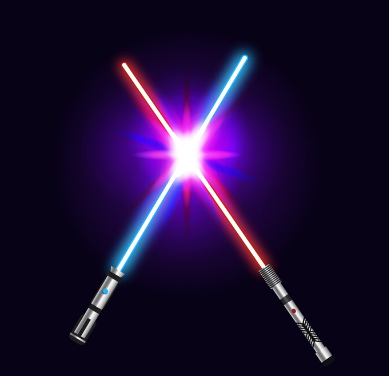In the vast universe of science fiction and fantasy, few weapons have captured the imagination of fans quite like the lightsaber. With its iconic appearance and unique abilities, the lightsaber has become a symbol of heroism and adventure. In this blog, we will delve into the history, mechanics, and cultural impact of this legendary weapon, exploring why it continues to be a beloved and enduring symbol in popular culture.
The Birth of the Lightsaber
The lightsaber made its first appearance in the original 1977 Star Wars film, "Star Wars: Episode IV - A New Hope." Created by George Lucas and brought to life by the brilliant special effects team at Lucasfilm, the lightsaber was an instant hit with audiences. Its elegant design, characterized by a hilt and a glowing blade of energy, instantly set it apart from other fictional weapons.
The concept behind the lightsaber was that it was a weapon of the Jedi, a group of mystical warriors who served as guardians of peace and justice in the galaxy. Jedi and Sith, their dark counterparts, were skilled in the use of the lightsaber, making it an integral part of their identities and battles.
Mechanics of a Lightsaber
At its core, a lightsaber is a plasma-based weapon, but the specifics of its construction and operation remain shrouded in mystery. In the Star Wars universe, lightsabers are powered by Kyber crystals, which are colorless until they are chosen by a Jedi or Sith. These crystals harness the Force and focus it into a blade of pure energy.
The blade of a lightsaber is unique in that it has no mass, yet it can cut through almost anything with ease. This makes it an incredibly versatile weapon, both for combat and for defense. The blade's color is determined by the Kyber crystal used, with blue and green typically associated with Jedi and red with Sith. However, exceptions and variations exist, adding depth to the lore.
A lightsaber's hilt is as distinctive as its blade, often reflecting the personality and style of its owner. Some Jedi prefer a simple and elegant design, while others adorn their hilts with intricate details and decorations. The hilt also houses the power source and the focusing crystal, making it a crucial component of the weapon.
Cultural Impact and Popularity
The lightsaber's popularity extends far beyond the Star Wars franchise. It has become a symbol of heroism, justice, and the battle between good and evil. Countless fans have wielded toy lightsabers in their own imaginative duels, and the distinct humming sound of a lightsaber igniting has become an instantly recognizable audio cue in popular culture.
The lightsaber's influence reaches beyond the realm of movies and television. It has inspired countless books, comics, video games, and merchandise, creating a vast and immersive expanded universe for fans to explore. Lightsaber duels are a staple in Star Wars video games, allowing players to experience the thrill of combat with these iconic weapons firsthand.
Moreover, lightsabers have also made appearances in other science fiction and fantasy franchises, paying homage to their impact. From animated series like "Star Wars: The Clone Wars" to parodies in shows like "Family Guy" and "The Simpsons," the lightsaber's legacy endures through references and homages.
The Jedi Code and Philosophy
The lightsaber is not just a weapon; it is a symbol of the Jedi way of life. Jedi adhere to a strict code of ethics, emphasizing peace, self-discipline, and the responsible use of their abilities. The lightsaber serves as both a tool for defense and a symbol of their commitment to these principles.
The Jedi Code promotes harmony and selflessness, making Jedi guardians of peace and justice in the galaxy. They use their lightsabers to protect the innocent and uphold these values, often facing formidable adversaries, including Sith Lords and other dark side users.
The Force, an energy field that connects all living things, plays a central role in the Jedi philosophy. They use the Force to enhance their abilities, including their mastery of the lightsaber. The lightsaber becomes an extension of the Jedi's will, guided by the Force itself.
The Dark Side and Sith Lightsabers
While the Jedi represent the light side of the Force, the Sith embrace the dark side. Sith lightsabers are often red, signifying their corruption and deviation from the Jedi path. Sith focus on their own desires for power and dominance, often using their lightsabers with lethal intent.
Sith lightsabers are typically synthetic crystals, artificially created to bleed and turn red. This process symbolizes the Sith's rejection of the Jedi way and their descent into darkness. Sith lightsabers often have a more aggressive and menacing design compared to the elegant and refined Jedi lightsabers.
Conclusion
The lightsaber is a legendary weapon that has left an indelible mark on popular culture. Its elegant design, mysterious mechanics, and deep connection to the Star Wars universe have made it an enduring symbol of heroism and adventure. The lightsaber's cultural impact extends far beyond the silver screen, influencing books, games, and countless other forms of media.
Beyond its status as a weapon, the lightsaber embodies the values and philosophies of the Jedi, emphasizing peace, justice, and the responsible use of power. In the ongoing battle between the light side and the dark side of the Force, the lightsaber stands as a powerful and iconic symbol of hope and the enduring fight for good in the face of evil.
As we celebrate the lightsaber's legacy on its 1,000-word birthday, we can't help but marvel at the enduring magic it has brought to our lives through the stories of Star Wars and the boundless imagination it has ignited in fans of all ages. May the Force be with you, always.





